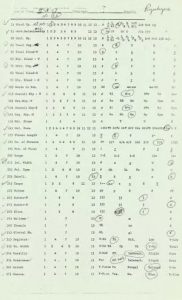Article index
What is ethnomusicology?
The term "ethnomusicology" already contains some important information that helps to identify the field of studies to which we refer: the words ethno (from ethnology) and music. In general, it could therefore be said that ethnomusicology "studies the forms and musical behaviors of societies and cultures of ethnological interest" [1].
Common trait of these cultures is the oral transmission of one's knowledge. Therefore ethnomusicology "studies the forms and musical behaviors of oral tradition". [2]
In the concept of oral tradition, you can refer primarily to the dimension of the vocal repertoire. Among the best known and most important studies for quantity and variety of material (vocal) examined from an ethnomusicological point of view, the research of Alan Lomax stands out.
Alan Lomax - The Global Jukebox
 Alan Lomax, an American ethnomusicologist, has collected in numerous field research (carried out between the United States, England, Spain and Italy as early as the early 1900s) the largest popular vocal repertoire sound archive.
Alan Lomax, an American ethnomusicologist, has collected in numerous field research (carried out between the United States, England, Spain and Italy as early as the early 1900s) the largest popular vocal repertoire sound archive.
To him we owe the first recordings of great blues artists, folk and jazz such as Muddy Waters and Woody Guthrie.
The research of 1953-54, commissioned by the BBC and carried out together with the father of Italian ethnomusicology Diego Carpitella; A journey into the tradition of Italian popular music that finds a faithful report in his book
“The happiest year of my life. A trip to Italy "(1954-54), Il Saggiatore, Milan, 2008 (link to the book)
and in the record publications "Italian Treasury"
All the cultural heritage collected by Lomax is kept by the Association for Cultural Equity (founded by himself in 1986).
This material then merged around 1990 in a sort of interactive global archive "The Global Jukebox"; The portal is divided on the basis of geographical-cultural indications and is divided into the "cantometric" and "choreometric" criterion (method that tries to distinguish the various cultures based on their approach to singing and dance).
Obviously the ethnomusicological research in the vocal field is very vast; An extremely interesting job is that of Steven Feld regarding the analysis of the form and execution of singing in the vision of the Kaluli population in Papua New Guinea.
Voices in the forest, poetic, song and expression Kaluli
 The American ethnomusicologist Steven Feld conducted in 1976 (together with the pair of anthropologists Edward and Bambi Siaffelin, in the rainforest at the Bosavi volcano in the Plain of Papua New Guinea) a study on the population of the Kaluli, observing for more than twenty years their life and their musical poetics.
The American ethnomusicologist Steven Feld conducted in 1976 (together with the pair of anthropologists Edward and Bambi Siaffelin, in the rainforest at the Bosavi volcano in the Plain of Papua New Guinea) a study on the population of the Kaluli, observing for more than twenty years their life and their musical poetics.
The central theme of all this research work originates from the most important story of the Kaluli population: the myth of the child who became a muni bird (it is one of the twelve Kaluli stories on birds that connect the sound world of birds with that of human sounds) .
History describes two shrimp fishing brothers; The minor little brother finding nothing to eat, he starts whining but does not get food from the older sister, in the end the little one finds a shrimp, tightening it into his hand turns into a bird and flies away by intoning a descending eeeeee: the call of the bird muni ; The sister, desperate, implores him in vain to go back and return human.
In this myth all the essential themes are enclosed to understand the expression Kaluli: the male/female, the relationship of brotherhood (adè), food, hunger, reciprocity (support), sadness, loss, abandonment , the lament and the song.
Compared to these themes, the sound methods of the Kaluli are expressive representations of two fundamental concepts for them: feeling and plea.
It is important to underline that for the Kaluli the birds are ane mama: manifestations of the spirits of their dead, these animals therefore have a profound connection with the human world.
It must also be said that, in this context, birds are distinguished according to the sounds they produce (the birds that sing, those who cry, those who whistle, those who speak in Bosavi language, those who say their name, those who only produce sound and those who make a lot of noise); Being therefore both animal representation of the dead, and articulated sound world, in this sense the birds become a sort of metaphor of human society and their songs are specific forms of feeling.
From a musical point of view, the vocal form first for the Kaluli is the song Gisalo.
The song Gisalo: style and vocal execution
For the Kaluli, the concept of composition stands out in melody: Gisalo and Text: Sa-Gisalo.
The melody is linked to the symbolic call of the bird Muni, the words are those of the child in the myth after becoming a bird, so they are "sound words of birds" [3].
The concept of composition arises from a melody "all around", "in the air", from the sounds of the birds; Melodically, the two most important intervals are the second largest descendant and the third minor descendant.
 The essential element for what concerns the style and technique of execution is the vocal emission; The Kaluli describes it as a "Gisalo song voice", with this they refer to a voice that should be not nasalized, in the register of chest but not forced, the sound should be clear, well articulated but not detached, they define it as a sound that It must "go like water that flows on the stones".
The essential element for what concerns the style and technique of execution is the vocal emission; The Kaluli describes it as a "Gisalo song voice", with this they refer to a voice that should be not nasalized, in the register of chest but not forced, the sound should be clear, well articulated but not detached, they define it as a sound that It must "go like water that flows on the stones".
For the Kaluli, in fact, the two main executive problems emerge when the voice "cracks" (if the extension is too acute) and when it "breaks" (if too forced); A singer who struggles, for them, is a bad voice Dugano Mògago opposite to Dagano Ebelab: "Water that continues to scroll beyond the sight", a good singer must therefore possess a voice like water.
This detailed field research was published in: "Sound and feeling" , Steven Feld, Il Saggiatore, Milan, 2009; The book in 2018 also became a documentary film "Voices of the Rainforest".
[1] See F. Giannattasio "The concept of music" p.18
[2] See F. Giannattasio "The concept of music" p.19
[3] See s.feld "sound and feeling" p.181 and seg.








